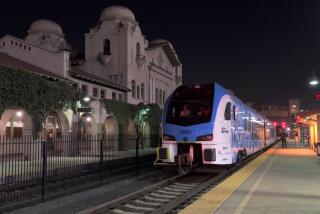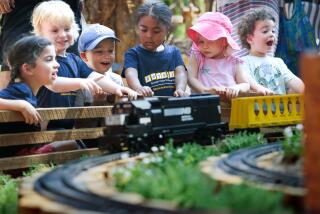Museum Offers Enthusiasts a Rail-Life Experience : The 50-acre Orange Empire Railway facility takes a look at a time when traveling by train and trolley was the norm.
PERRIS — With more than 60 cars capable of carrying passengers and 180 rail vehicles overall, Southern California has one of the most comprehensive rail transit systems in the United States.
Sadly, for those who must fight the freeways every day, all 180 are confined to the 50-acre Orange Empire Railway Museum in the town of Perris, 17 miles southeast of Riverside.
The museum began to take shape more than 30 years ago and today is the largest of its type on the West Coast to be run entirely by volunteers and without significant financial help from any private or public agency.
The museum is open every day of the year except Thanksgiving and Christmas, but is especially interesting on weekends and major holidays, when restored cars are running, pulled by electric, diesel or steam locomotives.
The facility has a pronounced California flavor, with cars from Los Angeles, San Francisco and San Diego, but others have been brought in from as far away as Vancouver, B.C.; Kyoto, Japan; and Dublin, Ireland. The blue, double-deck car from Dublin is nearly a century old.
The oldest car on display is a combination freight-passenger coach from 1879; the newest are trolleys that date from the 1940s, when the popularity of rail traffic was already beginning to decline. Not all are in operating condition, but the members and volunteers at the museum are confident nearly all will eventually get back on track.
“We have the time,” member Gordon Reeder of Culver City said. “We just don’t have the money. We have people who come from as far away as Bakersfield at least once a month to work on a project. We can’t get things done the way you can if you’re paying someone.”
Reeder, who sometimes operates the book and gift shop on weekends, knows about all aspects of the museum’s operation. In fact, all the members sound as though they could disassemble and rebuild a steam locomotive. Not surprisingly, then, nearly all the restoration and rebuilding is done at the museum. A wood shop and machine shop are on the premises.
As an example of the volunteers’ dedication, Bill Wisneski spent the Memorial Day weekend painting the ceiling of a Pacific Electric city streetcar a thick cream color, matching its rattan seats. He started at 10 one morning in Car Barn No. 2--there are four--and worked until a stiff neck forced him to quit around midnight.
Volunteers at the museum often speak of projects that take years. One Bakersfield and Kern Electric Railway car, built in 1900 and highlighted by mahogany seats and brass railings, was rebuilt over a period of six years by Joe and Norma Webber of Hemet. Virtually all their work was done on weekends and vacations.
Other volunteers operate the equipment--after a lengthy training program--while still others conduct tours, repair track, weld couplings, paint, repair wood, and punch the souvenir tickets that are replicas to the transfers given to streetcar patrons in the past.
In fact, the black-suited, white-shirted men and women resemble railroad employees, not weekend volunteers who are trying to show people too young to remember what kind of system once served the area.
More than half a century ago, rapid transit passengers could go from Pomona to Santa Monica, from Redlands to the San Fernando Valley, from Long Beach to Altadena. Some conspiracy theorists have claimed the trolleys were forced out of business by a consortium of tire manufacturers, car makers and oil companies.
Wally Richards, a San Juan Capistrano resident and retired salesman who repairs trains at the museum when not leading tours around it, doesn’t buy the theory.
“There’s no truth to it,” he said. “These were people who wanted to make money. If they had been making money, they would have stayed in business. The shame is that these cars were built so well, they could have run forever, almost with no maintenance.”
Conducting a walking tour, Richards pointed to a trolley that was used in Los Angeles for nearly three decades.
“They stopped using these in 1962,” he said, “and sold them to the system in Cairo, Egypt, where they ran for another 20 years.”
Richards likes to point out that several cities, including San Francisco, Sacramento and Portland, are returning to trolley systems--although they now call them light-rail systems--and that about 800 cars have been placed in service in the past 10 years.
Paul Hammond, a museum board member and vice president of the physical plant, is proud to note that the museum has enough equipment--much more than Los Angeles’ new Blue Line, for example--to handle all the transit needs of a city of 300,000.
Perhaps one of the reasons money is hard to come by is that the museum itself charges no admission although there is a charge for riding trains. All-day tickets, enabling visitors to ride any train being used that day, are $5 for adults and $3 for children 6 through 11. Children under 6 ride free.
The museum has a total of three miles of track, most of it donated by railroads as they ceased operation. Trains are operated on weekends and holidays from 11 a.m. to 5 p.m., while the museum and its book and gift shop open at 9 a.m. every day.
The gift shop, operated by volunteers, provides another source of revenue. It has a large selection of railroad books and magazines, along with T-shirts, watch fobs and belt buckles displaying the logos of firms that exist only in memory.
Memberships also are available, at different prices depending on degree of involvement. The museum has about 1,200 members, about 250 to 300 of whom constitute a nucleus of active volunteers.
Another major expert on the museum and train operation overall is Robert L. Shannon of West Covina. Shannon, a retired NBC executive, is assistant superintendent of railway operations.
“We actually have members from all over the world,” he said. “And people come here from almost everywhere.” Shannon said the museum has experienced steady growth in recent years, with nearly 20,000 people visiting last year. The figure is an estimate, since no records are kept.
“We get almost half our turnout from our Rail Festival and Fall Rail Festival,” Shannon said. The Rail Festival, held the last full weekend of April, is marked by more cars in operation, entertainment, railroad displays and food concessions. That event now draws about 6,000 people.
About half as many come to the Fall Rail Festival, held the last full weekend in October. Other attractions are railroad-related swap meets, scheduled for the first Saturdays in March and October.
Another attraction to the Rail Festival is that, for the past three years, museum officials have been able to get permission to take trains to the century-old Perris station, about two miles away, and back.
The museum faces problems as it continues to try to expand. One, of course, is finances. Another is parts availability.
“You can’t just go out and buy these old parts,” Reeder said. “You have to put a blue card on the train, say it’s out of service, and get down to fixing it.”
Some cars, particularly those in the worst condition, are cannibalized to provide mechanical parts for others.
Another problem is heat-related deterioration. Although it is dry in Perris, the summers are hot. Sitting uncovered, year after year, will destroy the cars. Accordingly, the four barns have been built to provide them with some shelter while they await repairs.
Also because of the heat, this has been a slow time for visitors. Shannon said the spring and fall usually bring the most visitors, with summer and winter the slowest, “but picking up.”
Those who visit the museum should know in advance that there are no food facilities, other than a few vending machines. Visitors can bring lunches and eat at tables on the museum grounds.
Free walking tours are the best way to see the equipment on display. A map in the guidebook, available in the gift shop, is also helpful.
The museum can be reached from Orange County by going eastbound on the Riverside Freeway to the southbound Interstate 15, and then northeast from Lake Elsinore to Perris on California 74. An alternative way from the southern part of Orange County would be to take the California 74 northeast from Mission Viejo.
The Orange Empire Railway Museum is at 2201 S. A St., Perris. The phone number is (714) 657-2605.
More to Read
Sign up for Essential California
The most important California stories and recommendations in your inbox every morning.
You may occasionally receive promotional content from the Los Angeles Times.









